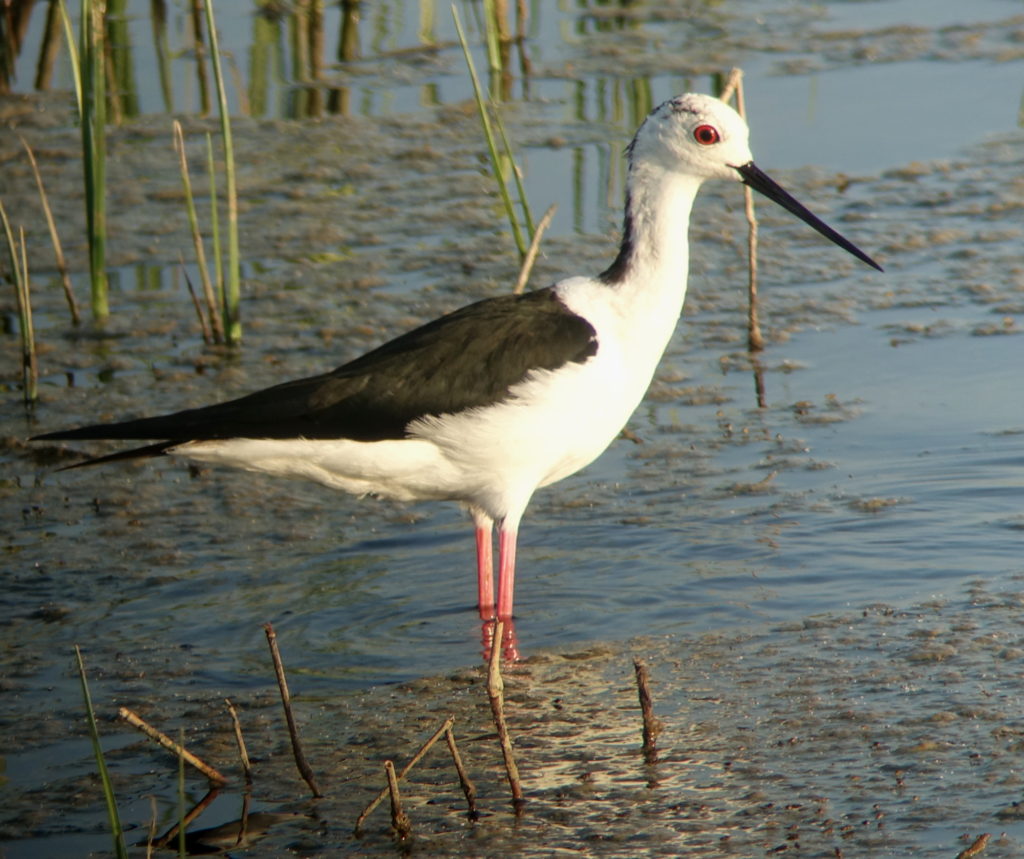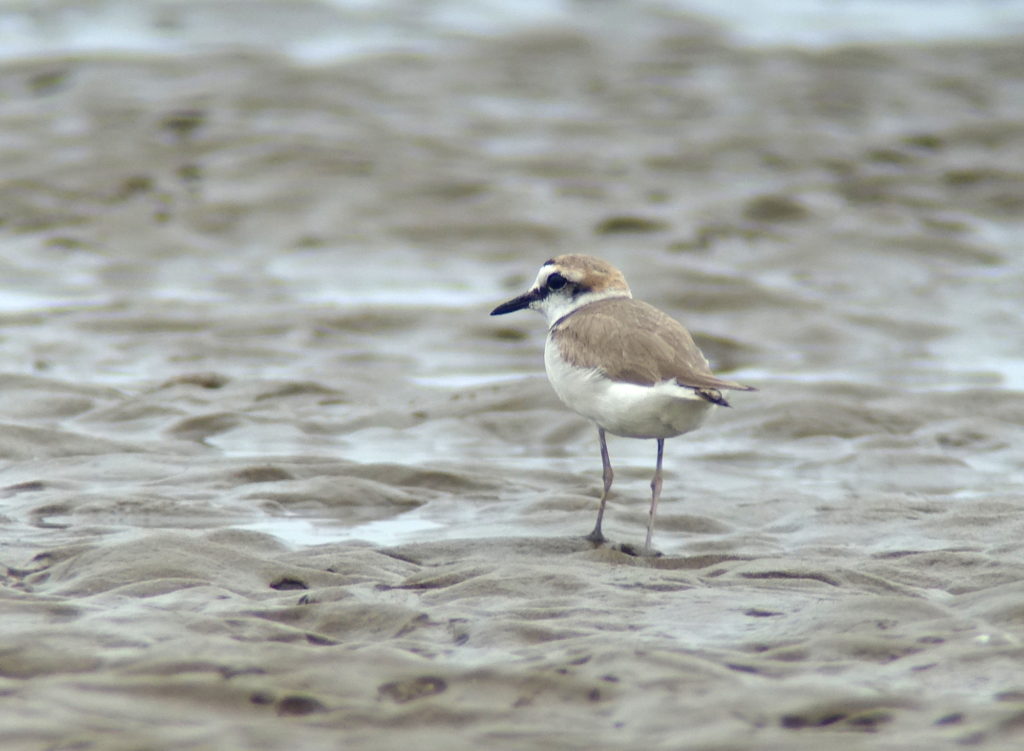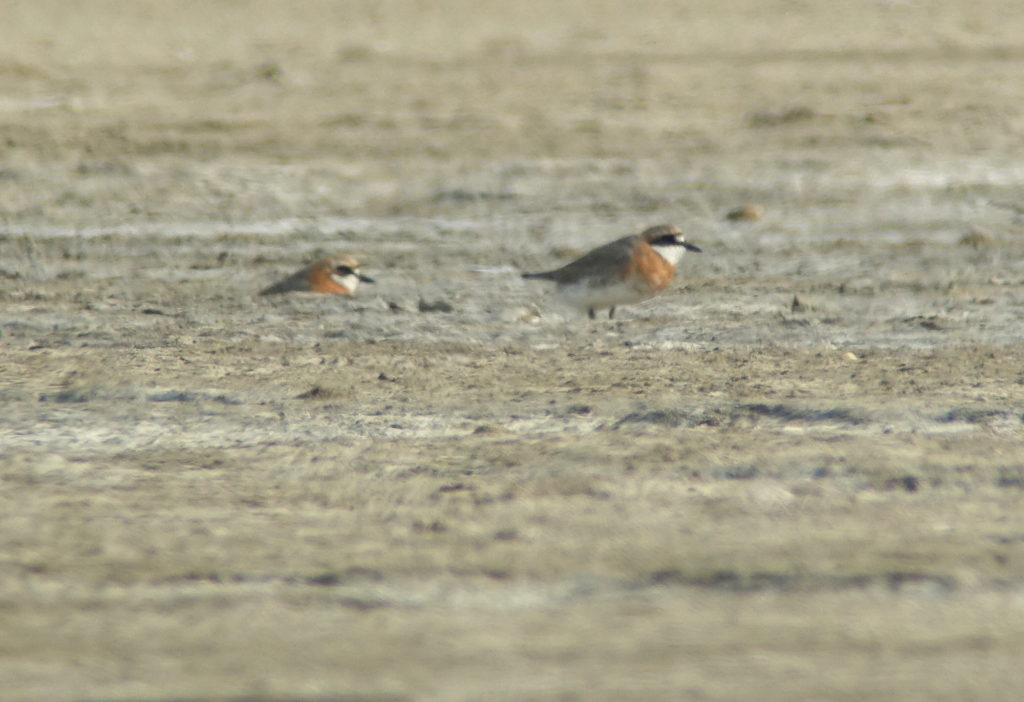Bird Research News from Nial Moores and Jason Loghry
Between June 19th and 25th, during just one week of rapid counting (with an especial focus on looking for over-summering Spoon-billed Sandpiper), we found a total of 28 shorebird species and internationally important concentrations of several Yellow Sea specials (e.g. the globally Endangered Black-faced Spoonbill, Vulnerable Chinese Egret and Vulnerable Saunders’s Gull).
 Black-faced Spoonbill Platalea minor (Adult and presumed Second calendar-year) © Nial Moores
Black-faced Spoonbill Platalea minor (Adult and presumed Second calendar-year) © Nial Moores
Although we failed to find any spoonies, we did find single Nordmann’s Greenshank (Endangered) and Oriental Pratincole, several thousand Far Eastern Curlew (globally Endangered, and now the focus of an EAAFP Single Species Action Plan), unexpectedly high numbers of both Grey Plover and Terek Sandpiper and a dozen or so shorebird species that are not even listed by the 2014 Birds Korea Checklist as occurring in the Republic of Korea in mid-summer.
Funded by the truly excellent SBS in China, our rapid survey covered Yeongjong South, Song Do, Namyang/Hwaseong, Seosan, the Geum Estuary, the massively degraded desert-lands of Saemangeum (the subject of a separate post), Gomso Bay, Baeksu, Suncheon Bay, Junam and the Nakdong Estuary. A more detailed report for SBS in China is now in progress and will be made available to Birds Korea members and conservation bodies on request.
In the meantime, below is a list of the shorebirds we recorded and their total numbers, followed by a few additional species of note:
- Far Eastern Oystercatcher Haematopus (ostralegus) osculans : 760
- Black-winged Stilt Himantopus himantopus : 58
 Adult Black-winged Stilt, presumably a male based on the greenish gloss to the dark looking upperparts © Nial Moores
Adult Black-winged Stilt, presumably a male based on the greenish gloss to the dark looking upperparts © Nial Moores
- Pacific Golden Plover Pluvialis fulva : 1

 Breeding-plumaged adult male (or rather less likely advanced Second Calendar-year?) Pacific Golden Plover, with Grey Plovers to rear © Nial Moores. Richard Chandler’s 2009 Shorebirds of the Northern Hempisphere states “birds with very worn primaries moulting to non-breeding are second calendar year.” This bird did not look to be in moult yet and the primaries did not look especially worn.
Breeding-plumaged adult male (or rather less likely advanced Second Calendar-year?) Pacific Golden Plover, with Grey Plovers to rear © Nial Moores. Richard Chandler’s 2009 Shorebirds of the Northern Hempisphere states “birds with very worn primaries moulting to non-breeding are second calendar year.” This bird did not look to be in moult yet and the primaries did not look especially worn.
- Grey Plover Pluvialis squatarola : 1,510
 Flock of Grey Plover (all Second Calendar-years?), with single Pacific Golden Plover, Bar-tailed Godwit and Dunlin © Nial Moores
Flock of Grey Plover (all Second Calendar-years?), with single Pacific Golden Plover, Bar-tailed Godwit and Dunlin © Nial Moores
- Long-billed Plover Charadrius placidus : 5
 (Presumed) First Calendar-year Long-billed Plover © Nial Moores
(Presumed) First Calendar-year Long-billed Plover © Nial Moores
- Little Ringed Plover Charadrius dubius : 59
- Kentish Plover Charadrius alexandrinus : 556
 Adult male Kentish Plover © Nial Moores
Adult male Kentish Plover © Nial Moores
- Mongolian Plover Charadrius mongolus mongolus : 31
 Mongolian Plover (apparently adult female and male in breeding plumage) © Nial Moores
Mongolian Plover (apparently adult female and male in breeding plumage) © Nial Moores
- Greater Sand Plover Charadrius leschenaultii : 8
 Greater Sand Plover, presumably a well-marked Second (or very poorly-marked Third?) Calendar-year based on the slight warmth to the breast band © Nial Moores. Several of the Greater Sand Plover seen during the survey showed much more extensive breeding plumage than this.
Greater Sand Plover, presumably a well-marked Second (or very poorly-marked Third?) Calendar-year based on the slight warmth to the breast band © Nial Moores. Several of the Greater Sand Plover seen during the survey showed much more extensive breeding plumage than this.
- Black-tailed Godwit Limosa limosa : 2
 Breeding-plumaged Black-tailed Godwit, presumably an adult based on the extent of replaced wing coverts in addition to the intensity of the plumage saturation, with Bar-tailed Godwit, Grey Plover and Far Eastern Curlew © Nial Moores
Breeding-plumaged Black-tailed Godwit, presumably an adult based on the extent of replaced wing coverts in addition to the intensity of the plumage saturation, with Bar-tailed Godwit, Grey Plover and Far Eastern Curlew © Nial Moores
- Bar-tailed Godwit Limosa lapponica : 44 (including at least 1 menzbieri and four baueri)
- Whimbrel Numenius phaeopus : 514
- Eurasian Curlew Numenius arquata : 266
 Three Eurasian Curlew with Far Eastern Curlew, showing some of the variation in the extent of richly-coloured breeding-plumage/ adult type scapulars and contrasting wing coverts © Nial Moores. Several of the Eurasian Curlew were already in active primary moult, suggested by David Melville (in lit. June 2017) to indicate immaturity.
Three Eurasian Curlew with Far Eastern Curlew, showing some of the variation in the extent of richly-coloured breeding-plumage/ adult type scapulars and contrasting wing coverts © Nial Moores. Several of the Eurasian Curlew were already in active primary moult, suggested by David Melville (in lit. June 2017) to indicate immaturity.
- Far Eastern Curlew Numenius madagascariensis : 3,398

 Far Eastern Curlew © Nial Moores. Separation of Second and Third calendar-years from full adults apparently depends mostly on the extent of wear visible on any retained primaries. This individual shows an extent of pink in the bill more expected of non-breeders. The visible primaries appeared to show some wear – within or beyond that expected in an adult in June?
Far Eastern Curlew © Nial Moores. Separation of Second and Third calendar-years from full adults apparently depends mostly on the extent of wear visible on any retained primaries. This individual shows an extent of pink in the bill more expected of non-breeders. The visible primaries appeared to show some wear – within or beyond that expected in an adult in June?
- Common Redshank Tringa totanus : 6
 Adult-type Common Redshank (right) with Grey-tailed Tattler to the left, Saemangeum © Jason Loghry
Adult-type Common Redshank (right) with Grey-tailed Tattler to the left, Saemangeum © Jason Loghry
- Marsh Sandpiper Tringa stagnatilis : 4
- Common Greenshank Tringa nebularia : 38
- Nordmann’s Greenshank Tringa guttifer : 1

 Nordmann’s Greenshank, presumably Second Calendar-year, with Grey Plover © Nial Moores. Ageing as a Second Calendar-year is based on the small number of blackish adult breeding-type feathers in the upperparts, and the very limited spotting on the underparts. Are there any/ many other records of oversummering Nordmann’s in Korea?
Nordmann’s Greenshank, presumably Second Calendar-year, with Grey Plover © Nial Moores. Ageing as a Second Calendar-year is based on the small number of blackish adult breeding-type feathers in the upperparts, and the very limited spotting on the underparts. Are there any/ many other records of oversummering Nordmann’s in Korea?
- Wood Sandpiper Tringa glareola : 6
- Grey-tailed Tattler Tringa brevipes : 17
 Breeding-plumaged Grey-tailed Tattler with Ruddy Turnstone on right © Nial Moores
Breeding-plumaged Grey-tailed Tattler with Ruddy Turnstone on right © Nial Moores
- Terek Sandpiper Xenus cinereus : 980
 Terek Sandpiper © Nial Moores. Although showing extensive black in the scapulars like a full breeding-plumaged adult, this bird had obvious paler and darker bars on the tertials. Do such bars indicate immaturity? If so, then might the fairly large numbers of Terek recorded during this survey suggest that quite a few Second Calendar-years migrate up to the Yellow Sea?
Terek Sandpiper © Nial Moores. Although showing extensive black in the scapulars like a full breeding-plumaged adult, this bird had obvious paler and darker bars on the tertials. Do such bars indicate immaturity? If so, then might the fairly large numbers of Terek recorded during this survey suggest that quite a few Second Calendar-years migrate up to the Yellow Sea?
- Common Sandpiper Actitis hypoleucos : 1
- Ruddy Turnstone Arenaria interpres : 17
- Great Knot Calidris tenuirostris : 98
 Adult Great Knot (on right) in “supplemental breeding plumage” with extensive rust-red on the scapulars (perhaps an early returning failed breeder?) with Grey Plover and Ruddy Turnstone © Nial Moores
Adult Great Knot (on right) in “supplemental breeding plumage” with extensive rust-red on the scapulars (perhaps an early returning failed breeder?) with Grey Plover and Ruddy Turnstone © Nial Moores
- Red Knot Calidris canutus : 3 (or 4)
 Presumed Second Calendar-year Red Knot (on right) with Great Knot © Nial Moores. Although Chandler (2009) states that First-breeding Red Knot looks “much as adult non-breeding”, this individual has scattered adult type feathers in the upperparts and obviously orange-washed underparts.
Presumed Second Calendar-year Red Knot (on right) with Great Knot © Nial Moores. Although Chandler (2009) states that First-breeding Red Knot looks “much as adult non-breeding”, this individual has scattered adult type feathers in the upperparts and obviously orange-washed underparts.
- Red-necked Stint Calidris ruficollis : 1
 Adult, breeding-plumaged Red-necked Stint © Nial Moores
Adult, breeding-plumaged Red-necked Stint © Nial Moores
- Dunlin Calidris alpina : 6
- Oriental Pratincole Glareola maldivarum : 1
 Oriental Pratincole, apparently an adult in non-breeding plumage © Jason Loghry
Oriental Pratincole, apparently an adult in non-breeding plumage © Jason Loghry
The presence of so many shorebirds in mid-late June – especially of the more numerous species – raises lots of important questions: were some of these birds early-returning failed breeders or were many of them immatures – perhaps immature Far Eastern Curlew, Grey Plover and Terek Sandpiper routinely depend on Yellow Sea tidal-flats during the boreal summer and have simply been overlooked as there has been so little survey effort at this time of year? Either way, it is clear that more research is needed, in order to improve upon counts; to work out the proportions of the various age classes of the shorebirds that do spend the boreal summer in Korea; and also to work out what these species are feeding on (in summer, and at other times of the year) – with the latter research most easily achievable through a mixture of video-recording (as in these examples now on Youtube of Eurasian and Far Eastern Curlews filmed by JL during the survey) and benthic studies.
In contrast, although we found suprisingly good numbers of some shorebird species, there were much lower numbers of Little Tern than expected (with, for example, the formerly massive colony in the Nakdong Estuary more or less deserted – presumably because of all the disturbance caused during recent summers by Busan City’s ill-advised litter-clearing activities).
Finally, a few non-shorebird species of note included: several species of duck and two Whooper Swan; three Eurasian and more than 650 Black-faced Spoonbills; 2-3 Purple Heron; c. 5 Yellow Bittern; 271 Chinese Egret; 881 Saunders’s Gull (almost all at Song Do); 3 Styan’s Grasshopper Warbler; and a half-asleep Eurasian Eagle-Owl sitting in a rice-field!



 From top to bottom: Black-faced Spoonbill; Purple Heron Ardea purpurea with Grey Herons; adult Chinese Egret Egretta eulophotes; and Eurasian Eagle-Owl Bubo bubo. All images © Nial Moores
From top to bottom: Black-faced Spoonbill; Purple Heron Ardea purpurea with Grey Herons; adult Chinese Egret Egretta eulophotes; and Eurasian Eagle-Owl Bubo bubo. All images © Nial Moores


They are incredibly beautiful. Thanks for putting in so much work.